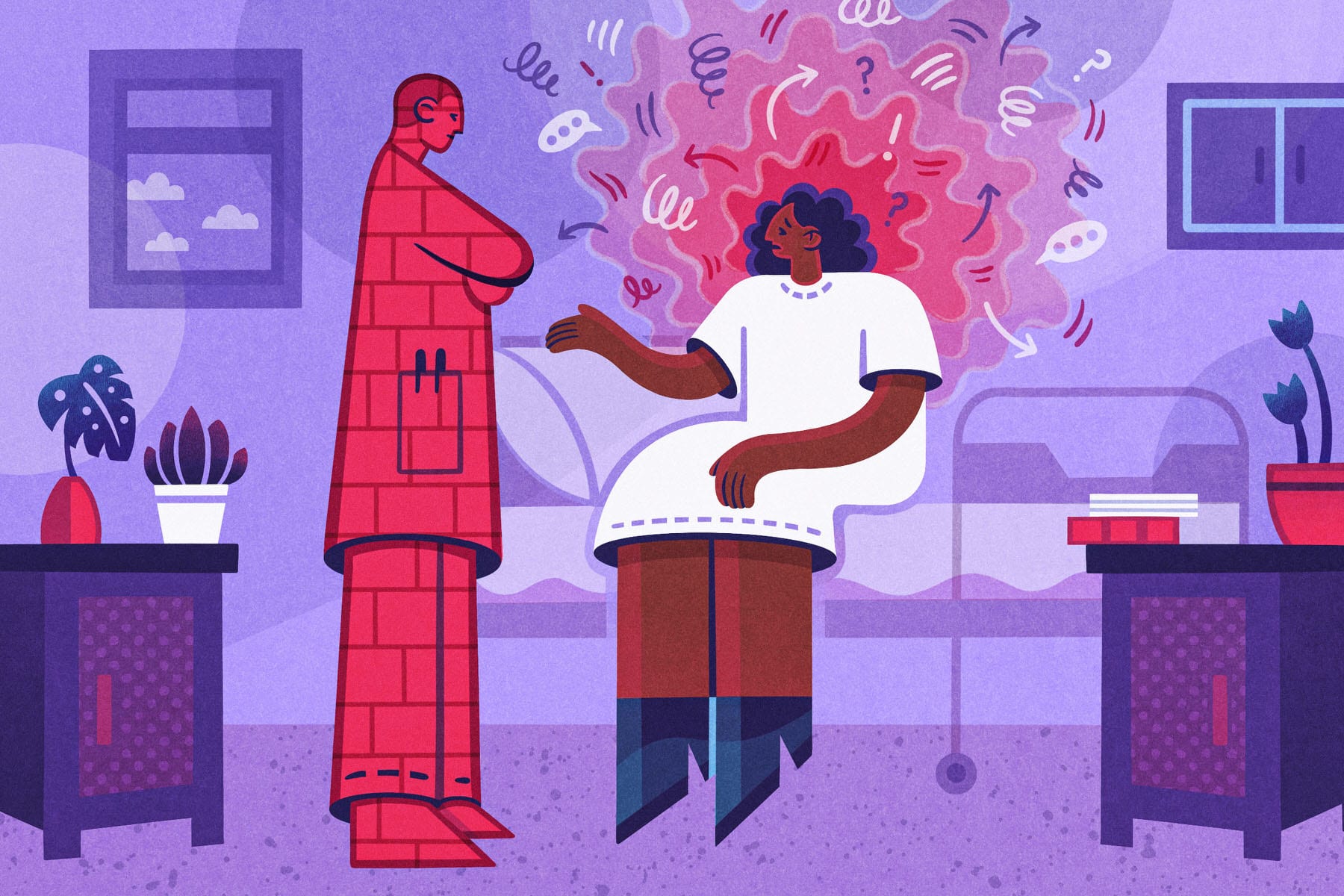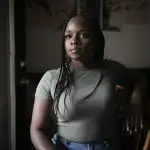Even before the pandemic, Sabra Thomas ordered her groceries. The 33-year-old has not been able to push a cart and her walker at the same time for years, and she can’t pick up heavy cases like water.
It’s the pain — the invisible enemy she faces daily.
In March 2020, when the pandemic set in and grocery orders surged, Thomas was never able to get hers delivered in time. She had to start placing orders five weeks ahead, and they kept getting canceled.
“I desperately needed food,” said Thomas, who has lived alone for the bulk of the pandemic. “And because of my chronic pain and feeling like food options were limited, I was rationing out my meals. Many days I had to figure out how to balance taking meds and how much to eat.”
Tasks that seem quotidian to so many have brought Thomas anxiety for years. At age 12, Thomas was diagnosed with Ehlers Danlos — a degenerative chronic pain condition affecting connective tissue, primarily the skin, joints and blood vessel walls.
She suspected, and later confirmed, that she was having hip dislocations all through childhood, which were constantly dismissed by doctors when she was younger, she said. When she finally received her diagnosis, she was told the disease would only progress as she got older. In high school, she was able to be more active, but the plays Thomas used to act in, the basketball and dance that defined her when she was growing up, have become nearly impossible activities now. The former dance instructor hasn’t danced in over a year.
On a good day prior to the pandemic, Thomas might go dance for a few hours with friends — though she would pay for it the next day. On a bad day, she was completely bedridden, usually waking up with joint dislocation, a migraine, vertigo or a combination of the three. The pain is always hidden.
“With a chronic pain condition, it’s like ‘OK, you look normal.’ I used to hate when people said that. What the heck does that mean, I look normal?” Thomas said. “I don’t feel normal.”
Now, Thomas lives in an apartment alone in Birmingham, Alabama, so she can be closer to family. Before moving, she hadn’t seen her family for a year. After pandemic-induced isolation and struggling to secure medical appointments, Thomas is tired. As a Black woman with chronic pain, she’s had to be her own medical advocate, she said.
“I’m here by myself. All I can focus on is my pain and the loneliness,” Thomas said. “I was feeling trapped, hopeless in all facets of my life.”
In the United States, 70 percent of people struggling with some form of chronic pain are women, despite 80 percent of studies on pain involving either men or mice. It’s a common pitfall of medical research that experts say could be because it is harder to get women of childbearing age to participate in studies. While research on pain is difficult given the ambiguous factors involved in feeling it, women report experiencing higher levels of pain than men, according to a study in Scientific American magazine.
There are vast disparities across both racial and gender lines when it comes to the validation of pain and getting treatment. Black patients are 40 percent less likely to receive medication for acute pain compared to White patients, and 34 percent less likely to be prescribed opioids, according to an analysis by the American Journal of Emergency Medicine.
That’s become even more difficult in the pandemic, experts say.
Thomas has long felt like she’s screaming to an empty auditorium when it comes to her checkups. Even when she was seeing doctors in-person, she seldom felt truly believed. In 2018, she waited months to see a top gynecologist for the excessive bleeding and pain she was having. Knowing her diagnosis, she thought the doctor, who was a White man, would surely run tests. He insisted it was her job — at the time she worked in social security as a customer service representative — that was making her stressed.
“I just felt very deflated,” Thomas said. “I felt like he was making me question myself.”
When Thomas went to get a second opinion by a doctor, a woman of color, she immediately found out she had to go into emergency surgery for eight inflamed fibroids linked to her Ehlers Danlos.
Now, Thomas is hardly able to secure in-person appointments because of a backlog from the pandemic. Virtually it’s much harder for her to show a physician her pain and explain her experience, she said.
The ambiguity around how people express their pain, coupled with ingrained biases and stereotypes, makes it hard for the most marginalized people to be taken seriously when explaining their pain, said Janice Sabin, a researcher on implicit bias in medicine at the University of Washington. This notion of “it’s all in your head” or “you’re crazy,” dates back a century when it comes to women and women of color experiencing chronic pain, Sabin said.
“The lived experience of discrimination is incredibly damaging. It is an emotional burden, but it’s also something that can be tapped intergenerationally,” Sabin said. “Women were considered to be in the 1950s, for example, ‘hysterical’ — just that legacy of not believing women and women being looked at as weak.”
Having to be your own advocate is the hardest, Thomas said. And especially during a pandemic, it is nearly impossible to stay on top of your own appointments and procedures. Typically, Thomas sees a specialist once a month and a therapist once a week. This year, Thomas tried to get into a new primary care doctor. She called to schedule in February for an appointment, and the earliest opening was in July. For someone in her level of constant pain, the wait is excruciating, forcing her to take her care into her own hands, doing her own medical research and reaching out to countless experts for advice and help.
“I had so much medical documentation,” Thomas said. “I could have made my own library.”
Telehealth skyrocketed at the beginning of the pandemic. Between June 26 and November 6, of 2020, 30.2 percent of weekly health center visits occurred via telehealth, according to the Centers for Disease Control and Prevention. Telehealth has made it easier for those in rural areas or for people who have children at home to get appointments, and experts say it’s here to stay: 83 percent of patients expect to use virtual appointments after the pandemic.
I felt like he was making me question myself.
On the flip side, it is more difficult for those like Thomas to feel completely understood. Vulnerable pain patients can be seen as seeking unneeded drugs when they simply need any remedy to get them out of bed, said Shoshana Aronowitz, a researcher of racial disparities in pain medications and the opioid crisis at the University of Pennsylvania. In the pandemic, the limited access to pain doctors affects those most marginalized, specifically women, people of color and LGBTQ+ people who may have previously experienced discrimination in treatment.
“We’ve gotten into the situation where people, especially Black Americans, have less access to pain care, and then also have less access to substance use disorder treatment. If people don’t have access to other types of treatment, that’s not OK,” Aronowitz said.
She advocates for a system in which the most marginalized are prioritized for a holistic approach to care that includes both telehealth and in-person therapy and remedies post-pandemic. There are a handful of pain centers across the country that view pain in this way, but with waitlists and costs for initial evaluation, they remain very inaccessible, experts said.
“In primary care, integrated team care is a model that is being advanced,” Sabin said. “Sort of having this medical home all in one place, so people aren’t being sent to a counselor for this and somewhere else for that. The providers in that model can discuss patients together. Everything is in one spot.”
Similar to chronic pain patients, many of whom struggle with undiagnosed ongoing medical problems, long-haul COVID patients face that same uncertain battle. With doctors spread thin working to address those with ongoing COVID-19 symptoms, Sabin hopes this is a turning point in which mysterious lingering chronic pain conditions can be looked at and appreciated in a new light.
Thomas decided last month to leave her job as a customer service representative and apply for disability status. Taking the phone calls her job required all day, especially when her pain flared up, was just not doable.
The pandemic pushed her to make changes that will help her take care of herself and the uncertainty of her condition. She still feels ashamed: That she can’t function to the extent she desires, that she has to endure the financial instability of a monthly check. She still hasn’t told many of her friends about quitting her job. When she has Zoom calls, she usually avoids the topic of work.
But still, she said, she is now ready to own her reality.
“For us in chronic pain, we’re always like, ‘We just got to keep going.’ ‘We push through it.’ And then by the time we finally stop, our body’s completely broken,” Thomas said. “So I’m trying not to do that because I am 33. I’m not 103.”
“Ironically, the pandemic gave me an out,” she added. “It was the catalyst to push me to make a change for myself, for the good of my health and well-being.”





